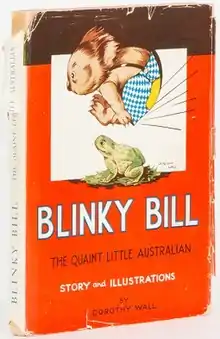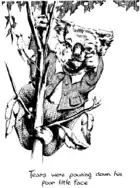Blinky Bill
Blinky Bill is an anthropomorphic koala and children's fictional character created by author and illustrator Dorothy Wall. The character of Blinky first appeared in Brooke Nicholls' 1933 book, Jacko – the Broadcasting Kookaburra,[1] which was illustrated by Wall. Wall then featured Blinky Bill in a series of her own books, including Blinky Bill: The Quaint Little Australian, Blinky Bill Grows Up, and Blinky Bill and Nutsy. The books are considered quintessential Australian children's classics, and have never been out of print in Australia.[2]
 Copy of the 1937 cover of Blinky Bill: The Quaint Little Australian by Dorothy Wall | |
| Author | Dorothy Wall |
|---|---|
| Country | Australia |
| Language | English |
| Genre | Children's literature |
| Published | 1933 Angus & Robertson |
| Media type | Illustrated audiobook |
Themes and writing style
While telling the adventures of Blinky Bill, a cheeky little boy in the form of a koala, the stories also present messages of conservation. Blinky Bill is known for his mischievousness and his love for his mother. His friends include his supposed girlfriend Nutsy, his kangaroo friend Splodge, and his mentor Mr. Wombat, as Blinky prefers to call him. In general, throughout the stories, he does things that are realistic for koalas as well as things that child readers would like to do. Wall tells the stories directly to the children and Blinky often interacts with the readers in an introduction. Her dedications are often to 'All the Kind Children', with her own son Peter and other common Australian names of the 1930s appearing. The books are also fully illustrated by Dorothy Wall herself.
History
The first book Blinky Bill: The Quaint Little Australian was published in 1933 by Angus & Robertson and was based on stories told to her only child, Peter.[3] The book is 69 pages long, with 15 pages of illustrations.[4] The second book, Blinky Bill Grows Up, was published in 1934 and is 82 pages long with 16 pages of illustrations.[5] The third book Blinky Bill and Nutsy: Two Little Australians was published in 1937 and is 115 pages long.[6] The Complete Adventures of Blinky Bill, first published in 1939, was reprinted 26 times between 1940 and 1965.[7]

Wall drew Blinky Bill comic strips, most notably one in 1937 called Blinky Bill's Escapades, which told of the adventures of Blinky, Nutsy and Splodge as they left Australia for the coronation of King George VI and Queen Elizabeth. Angus & Robertson made plates of four strips to entice publishers, but, after considerable procrastination, the Sydney Morning Herald turned it down. She persisted with the Herald for years along with the Sunday Telegraph. Wall also drew some full-page strips, in full colour, of Blinky Bill, Splodge and friends in the army, called Our Squad. Largely because of the cost and rarity of paper during the war, none was ever published.[8]
In 1940, Wall decided her priority was a new Blinky Bill book with Angus & Robertson. In a letter to her publisher, she wrote: "I'll have to do my utmost to get a new Blinky book out for next Christmas. I could do a good story with Blinky on National Service, providing the war continues – but I am not that wicked to wish such a thing".[8] In February 1940 she sent her publisher the completed text for Blinky Bill Joins the Army. The publisher was unimpressed by her story of Blinky as an enlisted soldier, calling it 'heavy going' and a too obvious exploitation of 'patriotic fervour'. Wall apparently tore up the manuscript and wrote an entirely new version where Blinky remains in his familiar bush setting until the final pages then goes off to join the army – as a mascot.[8] The new version was finished by the end of April 1940, less than a month after the first had been rejected; it was published for Christmas 1940.[9]
In December 1942 the Blinky Bill's Dress-Up Book was published by Offset Printing Company, which was released after Wall's death, in January 1942. This was followed in 1947 by Blinky Bill's ABC Book and A Tiny Story of Blinky Bill, also published by Offset. In 1977 Angus & Robertson published the Blinky Bill Cookbook, a series of recipes for children to make for themselves by Mary Coleman, which included Wall's original illustrations redrawn by Trevor Hood.[10]
Adaptations and cultural references
Although the books have never been out of print, the Blinky Bill story has also been adapted for television and cinema. The first television series from the 1980s, screened on the ABC was a live version featured actors interacting with puppet animals, titled The New Adventures of Blinky Bill. Blinky Bill was also made into an animated movie, Blinky Bill: The Mischievous Koala, by Yoram Gross Film Studios in 1992.[11] In 1993 there was a second children's series on the ABC Kids channel, called The Adventures of Blinky Bill. Computer games have been based on the Blinky Bill franchise, and these have been moderately successful.
In the 1980s Anne Keane gained the rights to reproduce both Dorothy Wall's Blinky Bill characters and the characters from Jimmy Bancks' Ginger Meggs comics.[1] She made a series of collectable dolls, with ceramic heads and feet with soft bodies made from imitation suede.
Blinky Bill is also the nickname of the light at the top of Sydney Harbour Bridge.[12]
In 1985 a postage stamp honouring Blinky or his creator was issued by Australia Post as part of a set of five commemorating children's books. .
In 1986, Australian singer John Williamson released a single titled "Goodbye Blinky Bill" raising awareness of decline in koala numbers in Australia.
In 1993, The Australian republican movement used the character as a symbol in the referendum the following year.[13]
A new Blinky Bill CGI film, Blinky Bill the Movie, was released on 17 September 2015.[14] It was followed by a TV series The Wild Adventures of Blinky Bill that began airing in 2016 on Seven Network.[15]
Reception
Blinky Bill received critical acclaim, and has become a national icon for Australia. Both the books and TV series are recognised internationally and regarded as children's classics.[16]
References
- "Blinky Bill Figurine". Powerhouse Museum. Retrieved 3 December 2008.
- Jackson, Stephen (2008). Koala: Origins of an Icon. Allen & Urwin. ISBN 978-1-74175-031-7. Retrieved 6 January 2008.
- "Wall, Dorothy (1894–1942)". Australian Dictionary of Biography. Retrieved 2 December 2008.
- "Blinky Bill". National Library of Australia. Retrieved 2 December 2008.
- "Blinky Bill Grows Up". National Library of Australia. Retrieved 2 December 2008.
- "Blinky Bill and Nutsy". National Library of Australia. Retrieved 2 December 2008.
- Lewis, Julian (2 April 2008). "Creating a cuddly koala". The Daily Telegraph. Retrieved 2 November 2008.
- "Dorothy Wall". Dictionary of Australian Artists Online. Retrieved 2 December 2008.
- "Blinky Bill joins the Army". National Library of Australia. Retrieved 2 December 2008.
- Blinky Bill Cookbook. National Library of Australia. 1981. ISBN 9780207141348. Retrieved 3 December 2008.
- "Blinky Bill". IMDb. Retrieved 4 December 2008.
- "Night Bridge Climb". Getaway. 21 September 2000. Archived from the original on 20 February 2009. Retrieved 3 December 2008.
- "Quentin Bryce and Republican symbolism". Retrieved 15 July 2018.
- "Blinky Bill movie will star Ryan Kwanten, Toni Collette, Barry Humphries, Deborah Mailman and other big names". news.com.au. Retrieved 23 March 2015.
- "Little Nutbrown Hare and Blinky Bill return to Aussie screens". Retrieved 15 July 2018.
- "Blinky Bill". 25 April 2016. Archived from the original on 28 April 2016. Retrieved 25 April 2016.
External links
| Wikimedia Commons has media related to Blinky Bill. |
| Wikisource has original text related to this article: |
- Blinky Bill, The Quaint Little Australian story and decorations by Dorothy Wall (Sydney : Angus & Robertson, 1933) – digitised and held by the National Library of Australia. The first copy pressed, dedicated by the publisher to the author, is also held by the National Library of Australia.
- Blinky Bill by Dorothy Wall, A Project Gutenberg of Australia eBook
- Article at The Age